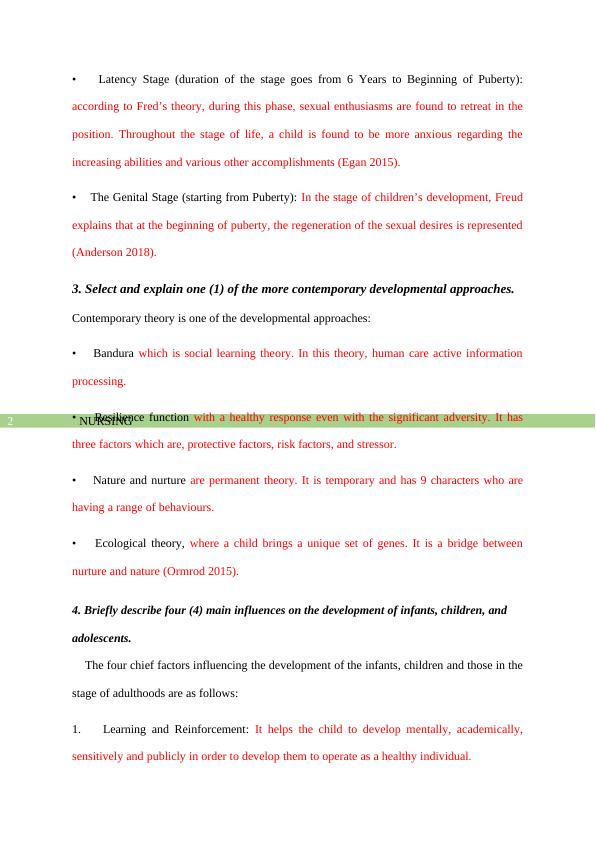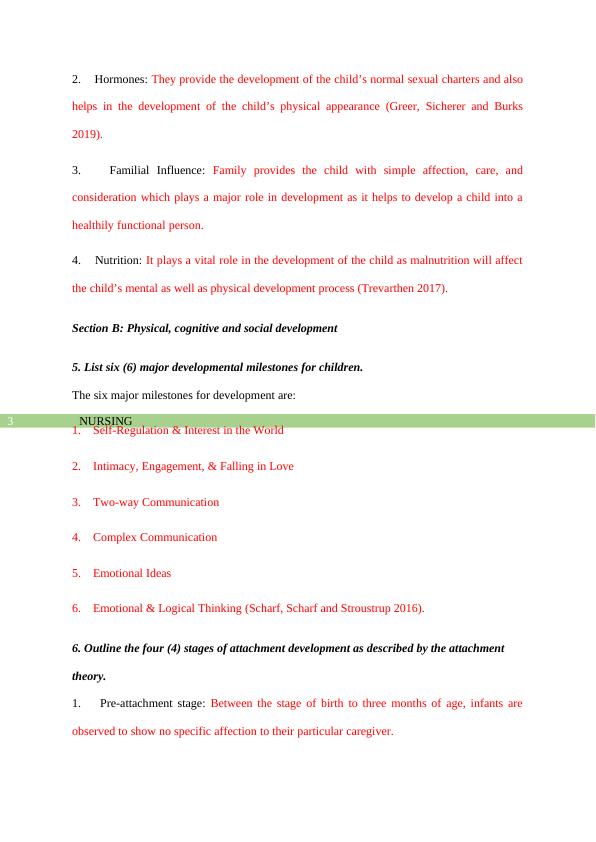Theories of Childhood Development and Developmental Milestones in Children
Added on 2022-12-19
17 Pages4231 Words38 Views
Running head: NURSING
NURSING
Name of the student:
Name of the university:
Author note:
NURSING
Name of the student:
Name of the university:
Author note:

NURSING1
Section A: Theories of lifespan and development.
1. Describe Freud’s theory of childhood development.
Sigmund Freud’s theory stated that every phase of development of a child is found to begin
at birth is properly connected to the definite requirements and demands. They are totally
based on a certain body part of the child and they are all embedded to sexual base (Hurry
2018). Freud also stated in his theory that the children’s early five years of lifespan are found
to be critical enough to the development of adult behaviour. He also had a viewpoint that
human life is circulated around tension and pleasure (Sasso 2018).
2. Outline the five (5) stages of the Freudian theory.
There are five stages of development outlined by Freud in his childhood development
theory which are as follows:
• The oral stage (duration is from birth to 18 months of age): According to Freud, the
infant’s mouth plays the role of the main erogenous zone. Freud stated that the erogenous
zone was the specific portion of the body from where an individual seeks out and achieves
pleasure (Freud 2015).
• The Anal Stage (duration is from 18 Months to the Three Years of early life): Freud stated
in this stage that throughout this life period, children develop their pleasure from the
progression of both absorbent and removing faeces. It is also observed that they are
moderately attentive towards the process (Silverman 2017).
• The Phallic Stage (duration of the stage is from 3 Years to 6 Years of life): According to
Freud, the pleasure of the children is attentive towards their genitals. It centres towards the
self-manipulation of their genitals which is found to be approving the chief cause of their
pleasurable encouragement (Berzoff 2016).
Section A: Theories of lifespan and development.
1. Describe Freud’s theory of childhood development.
Sigmund Freud’s theory stated that every phase of development of a child is found to begin
at birth is properly connected to the definite requirements and demands. They are totally
based on a certain body part of the child and they are all embedded to sexual base (Hurry
2018). Freud also stated in his theory that the children’s early five years of lifespan are found
to be critical enough to the development of adult behaviour. He also had a viewpoint that
human life is circulated around tension and pleasure (Sasso 2018).
2. Outline the five (5) stages of the Freudian theory.
There are five stages of development outlined by Freud in his childhood development
theory which are as follows:
• The oral stage (duration is from birth to 18 months of age): According to Freud, the
infant’s mouth plays the role of the main erogenous zone. Freud stated that the erogenous
zone was the specific portion of the body from where an individual seeks out and achieves
pleasure (Freud 2015).
• The Anal Stage (duration is from 18 Months to the Three Years of early life): Freud stated
in this stage that throughout this life period, children develop their pleasure from the
progression of both absorbent and removing faeces. It is also observed that they are
moderately attentive towards the process (Silverman 2017).
• The Phallic Stage (duration of the stage is from 3 Years to 6 Years of life): According to
Freud, the pleasure of the children is attentive towards their genitals. It centres towards the
self-manipulation of their genitals which is found to be approving the chief cause of their
pleasurable encouragement (Berzoff 2016).

NURSING2
• Latency Stage (duration of the stage goes from 6 Years to Beginning of Puberty):
according to Fred’s theory, during this phase, sexual enthusiasms are found to retreat in the
position. Throughout the stage of life, a child is found to be more anxious regarding the
increasing abilities and various other accomplishments (Egan 2015).
• The Genital Stage (starting from Puberty): In the stage of children’s development, Freud
explains that at the beginning of puberty, the regeneration of the sexual desires is represented
(Anderson 2018).
3. Select and explain one (1) of the more contemporary developmental approaches.
Contemporary theory is one of the developmental approaches:
• Bandura which is social learning theory. In this theory, human care active information
processing.
• Resilience function with a healthy response even with the significant adversity. It has
three factors which are, protective factors, risk factors, and stressor.
• Nature and nurture are permanent theory. It is temporary and has 9 characters who are
having a range of behaviours.
• Ecological theory, where a child brings a unique set of genes. It is a bridge between
nurture and nature (Ormrod 2015).
4. Briefly describe four (4) main influences on the development of infants, children, and
adolescents.
The four chief factors influencing the development of the infants, children and those in the
stage of adulthoods are as follows:
1. Learning and Reinforcement: It helps the child to develop mentally, academically,
sensitively and publicly in order to develop them to operate as a healthy individual.
• Latency Stage (duration of the stage goes from 6 Years to Beginning of Puberty):
according to Fred’s theory, during this phase, sexual enthusiasms are found to retreat in the
position. Throughout the stage of life, a child is found to be more anxious regarding the
increasing abilities and various other accomplishments (Egan 2015).
• The Genital Stage (starting from Puberty): In the stage of children’s development, Freud
explains that at the beginning of puberty, the regeneration of the sexual desires is represented
(Anderson 2018).
3. Select and explain one (1) of the more contemporary developmental approaches.
Contemporary theory is one of the developmental approaches:
• Bandura which is social learning theory. In this theory, human care active information
processing.
• Resilience function with a healthy response even with the significant adversity. It has
three factors which are, protective factors, risk factors, and stressor.
• Nature and nurture are permanent theory. It is temporary and has 9 characters who are
having a range of behaviours.
• Ecological theory, where a child brings a unique set of genes. It is a bridge between
nurture and nature (Ormrod 2015).
4. Briefly describe four (4) main influences on the development of infants, children, and
adolescents.
The four chief factors influencing the development of the infants, children and those in the
stage of adulthoods are as follows:
1. Learning and Reinforcement: It helps the child to develop mentally, academically,
sensitively and publicly in order to develop them to operate as a healthy individual.

NURSING3
2. Hormones: They provide the development of the child’s normal sexual charters and also
helps in the development of the child’s physical appearance (Greer, Sicherer and Burks
2019).
3. Familial Influence: Family provides the child with simple affection, care, and
consideration which plays a major role in development as it helps to develop a child into a
healthily functional person.
4. Nutrition: It plays a vital role in the development of the child as malnutrition will affect
the child’s mental as well as physical development process (Trevarthen 2017).
Section B: Physical, cognitive and social development
5. List six (6) major developmental milestones for children.
The six major milestones for development are:
1. Self-Regulation & Interest in the World
2. Intimacy, Engagement, & Falling in Love
3. Two-way Communication
4. Complex Communication
5. Emotional Ideas
6. Emotional & Logical Thinking (Scharf, Scharf and Stroustrup 2016).
6. Outline the four (4) stages of attachment development as described by the attachment
theory.
1. Pre-attachment stage: Between the stage of birth to three months of age, infants are
observed to show no specific affection to their particular caregiver.
2. Hormones: They provide the development of the child’s normal sexual charters and also
helps in the development of the child’s physical appearance (Greer, Sicherer and Burks
2019).
3. Familial Influence: Family provides the child with simple affection, care, and
consideration which plays a major role in development as it helps to develop a child into a
healthily functional person.
4. Nutrition: It plays a vital role in the development of the child as malnutrition will affect
the child’s mental as well as physical development process (Trevarthen 2017).
Section B: Physical, cognitive and social development
5. List six (6) major developmental milestones for children.
The six major milestones for development are:
1. Self-Regulation & Interest in the World
2. Intimacy, Engagement, & Falling in Love
3. Two-way Communication
4. Complex Communication
5. Emotional Ideas
6. Emotional & Logical Thinking (Scharf, Scharf and Stroustrup 2016).
6. Outline the four (4) stages of attachment development as described by the attachment
theory.
1. Pre-attachment stage: Between the stage of birth to three months of age, infants are
observed to show no specific affection to their particular caregiver.

End of preview
Want to access all the pages? Upload your documents or become a member.
Related Documents
Human Development Across the Lifespanlg...
|7
|1625
|393
Human Development across Lifespanlg...
|7
|1766
|72
Sigmund Freud Vs Eric Erikson | Assignmentlg...
|10
|1712
|312
Relationship between Developmental Psychology and Lifespan Developmentlg...
|4
|772
|137
Psychosocial Development across the Lifespanlg...
|5
|871
|250
Differences in the Views of Developmentlg...
|4
|563
|21
